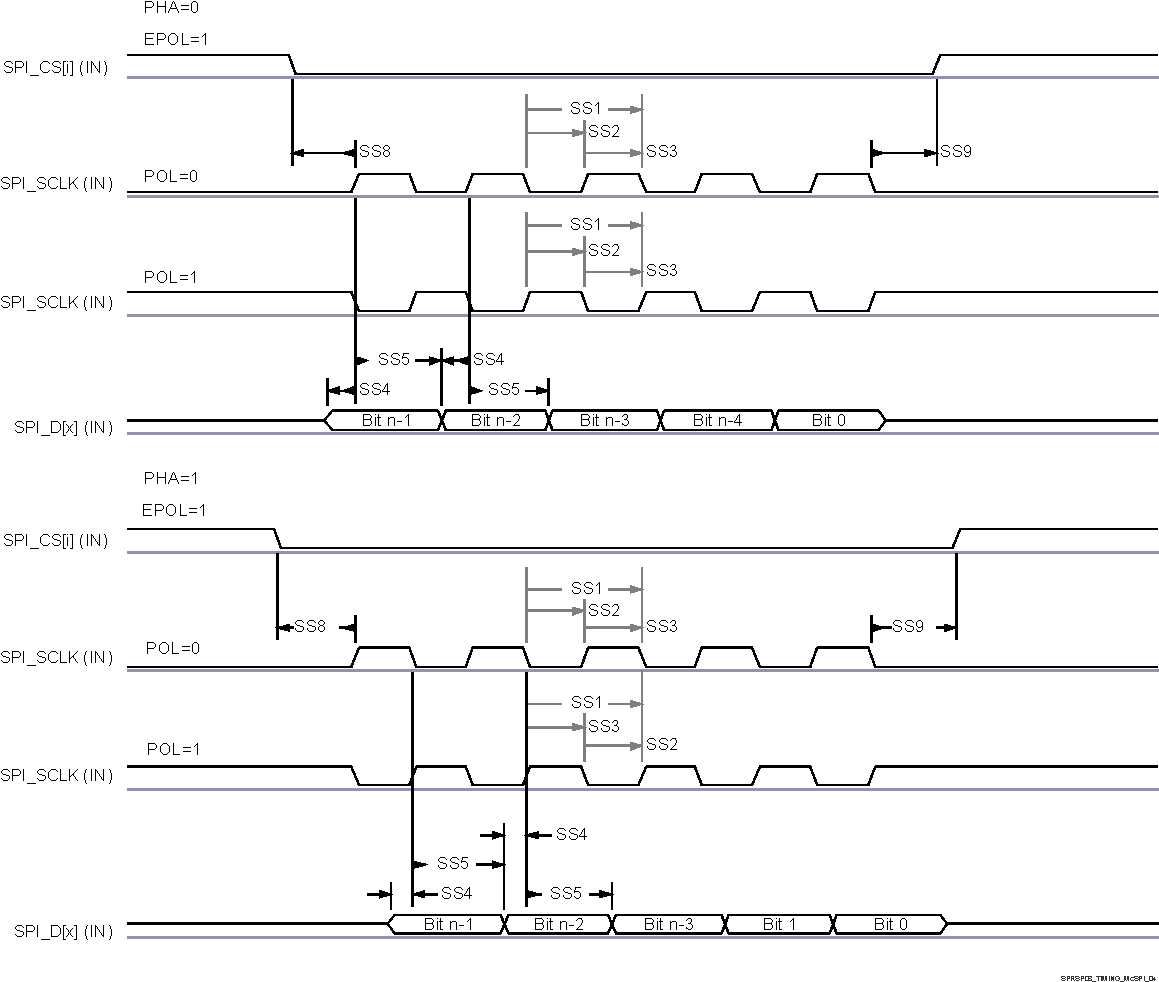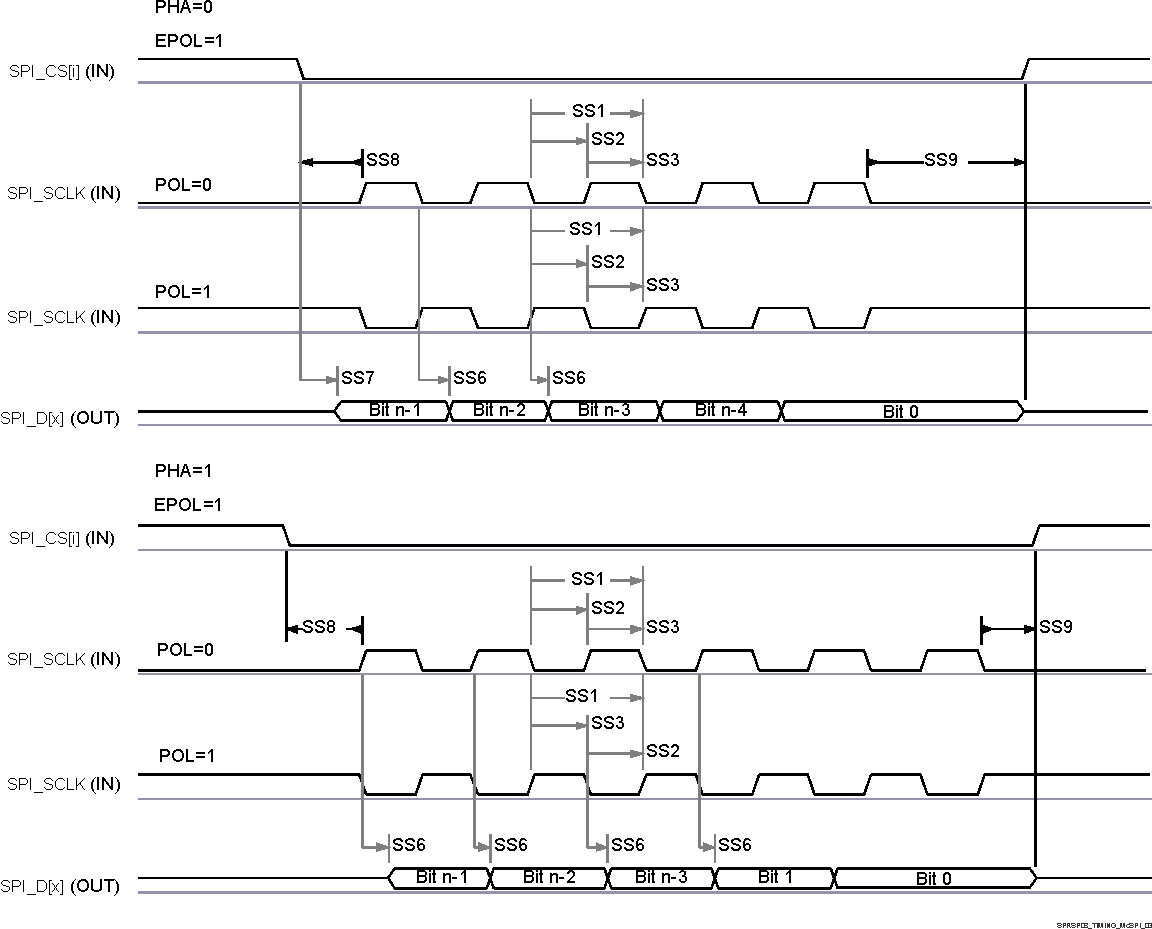SPRSP58B june 2022 – june 2023 AM620-Q1 , AM623 , AM625 , AM625-Q1
PRODUCTION DATA
- 1
- 1 Features
- 2 Applications
- 3 Description
- 4 Revision History
- 5 Device Comparison
-
6 Terminal Configuration and Functions
- 6.1 Pin Diagrams
- 6.2 Pin Attributes
- 6.3
Signal Descriptions
- 15
- 6.3.1 CPSW3G
- 6.3.2 CPTS
- 6.3.3 CSI-2
- 6.3.4 DDRSS
- 6.3.5 DSS
- 6.3.6 ECAP
- 6.3.7 Emulation and Debug
- 6.3.8 EPWM
- 6.3.9 EQEP
- 6.3.10 GPIO
- 6.3.11 GPMC
- 6.3.12 I2C
- 6.3.13 MCAN
- 6.3.14 MCASP
- 6.3.15 MCSPI
- 6.3.16 MDIO
- 6.3.17 MMC
- 6.3.18 OLDI
- 6.3.19 OSPI
- 6.3.20 Power Supply
- 6.3.21 PRUSS
- 6.3.22 Reserved
- 6.3.23 System and Miscellaneous
- 6.3.24 TIMER
- 6.3.25 UART
- 6.3.26 USB
- 6.4 Pin Connectivity Requirements
-
7 Specifications
- 7.1 Absolute Maximum Ratings
- 7.2 ESD Ratings for Devices which are not AEC - Q100 Qualified
- 7.3 ESD Ratings for AEC - Q100 Qualified Devices in the AMC Package
- 7.4 Power-On Hours (POH)
- 7.5 Recommended Operating Conditions
- 7.6 Operating Performance Points
- 7.7 Power Consumption Summary
- 7.8
Electrical
Characteristics
- 7.8.1 I2C Open-Drain, and Fail-Safe (I2C OD FS) Electrical Characteristics
- 7.8.2 Fail-Safe Reset (FS RESET) Electrical Characteristics
- 7.8.3 High-Frequency Oscillator (HFOSC) Electrical Characteristics
- 7.8.4 Low-Frequency Oscillator (LFXOSC) Electrical Characteristics
- 7.8.5 SDIO Electrical Characteristics
- 7.8.6 LVCMOS Electrical Characteristics
- 7.8.7 OLDI LVDS (OLDI) Electrical Characteristics
- 7.8.8 CSI-2 (D-PHY) Electrical Characteristics
- 7.8.9 USB2PHY Electrical Characteristics
- 7.8.10 DDR Electrical Characteristics
- 7.9 VPP Specifications for One-Time Programmable (OTP) eFuses
- 7.10 Thermal Resistance Characteristics
- 7.11
Timing and Switching Characteristics
- 7.11.1 Timing Parameters and Information
- 7.11.2 Power Supply Requirements
- 7.11.3 System Timing
- 7.11.4
Clock Specifications
- 7.11.4.1 Input Clocks / Oscillators
- 7.11.4.2 Output Clocks
- 7.11.4.3 PLLs
- 7.11.4.4 Recommended System Precautions for Clock and Control Signal Transitions
- 7.11.5
Peripherals
- 7.11.5.1 CPSW3G
- 7.11.5.2 CPTS
- 7.11.5.3 CSI-2
- 7.11.5.4 DDRSS
- 7.11.5.5 DSS
- 7.11.5.6 ECAP
- 7.11.5.7 Emulation and Debug
- 7.11.5.8 EPWM
- 7.11.5.9 EQEP
- 7.11.5.10 GPIO
- 7.11.5.11 GPMC
- 7.11.5.12 I2C
- 7.11.5.13 MCAN
- 7.11.5.14 MCASP
- 7.11.5.15 MCSPI
- 7.11.5.16
MMCSD
- 7.11.5.16.1
MMC0 - eMMC/SD/SDIO Interface
- 7.11.5.16.1.1 Legacy SDR Mode
- 7.11.5.16.1.2 High Speed SDR Mode
- 7.11.5.16.1.3 HS200 Mode
- 7.11.5.16.1.4 Default Speed Mode
- 7.11.5.16.1.5 High Speed Mode
- 7.11.5.16.1.6 UHS–I SDR12 Mode
- 7.11.5.16.1.7 UHS–I SDR25 Mode
- 7.11.5.16.1.8 UHS–I SDR50 Mode
- 7.11.5.16.1.9 UHS–I DDR50 Mode
- 7.11.5.16.1.10 UHS–I SDR104 Mode
- 7.11.5.16.2 MMC1/MMC2 - SD/SDIO Interface
- 7.11.5.16.1
MMC0 - eMMC/SD/SDIO Interface
- 7.11.5.17 OLDI
- 7.11.5.18 OSPI
- 7.11.5.19 PRUSS
- 7.11.5.20 Timers
- 7.11.5.21 UART
- 7.11.5.22 USB
-
8 Detailed Description
- 8.1 Overview
- 8.2 Processor Subsystems
- 8.3 Accelerators and Coprocessors
- 8.4 Other Subsystems
- 8.5
Peripherals
- 8.5.1 Gigabit Ethernet Switch (CPSW3G)
- 8.5.2 Camera Streaming Interface Receiver (CSI_RX_IF)
- 8.5.3 DDR Subsystem (DDRSS)
- 8.5.4 Display Subsystem (DSS)
- 8.5.5 Enhanced Capture (ECAP)
- 8.5.6 Error Location Module (ELM)
- 8.5.7 Enhanced Pulse Width Modulation (EPWM)
- 8.5.8 Error Signaling Module (ESM)
- 8.5.9 Enhanced Quadrature Encoder Pulse (EQEP)
- 8.5.10 General-Purpose Interface (GPIO)
- 8.5.11 General-Purpose Memory Controller (GPMC)
- 8.5.12 Global Timebase Counter (GTC)
- 8.5.13 Inter-Integrated Circuit (I2C)
- 8.5.14 Modular Controller Area Network (MCAN)
- 8.5.15 Multichannel Audio Serial Port (MCASP)
- 8.5.16 Multichannel Serial Peripheral Interface (MCSPI)
- 8.5.17 Multi-Media Card Secure Digital (MMCSD)
- 8.5.18 Octal Serial Peripheral Interface (OSPI)
- 8.5.19 Timers
- 8.5.20 Universal Asynchronous Receiver/Transmitter (UART)
- 8.5.21 Universal Serial Bus Subsystem (USBSS)
-
9 Applications,
Implementation, and Layout
- 9.1 Device Connection and Layout Fundamentals
- 9.2 Peripheral- and Interface-Specific Design Information
- 10Device and Documentation Support
- 11Mechanical, Packaging, and Orderable Information
Package Options
Refer to the PDF data sheet for device specific package drawings
Mechanical Data (Package|Pins)
- AMC|441
Thermal pad, mechanical data (Package|Pins)
Orderable Information
7.11.5.15.2 MCSPI — Peripheral Mode
Table 7-77, Figure 7-65, Table 7-78, and Figure 7-66 present timing requirements and switching characteristics for SPI – Peripheral Mode.
Table 7-77 MCSPI Timing Requirements – Peripheral
Mode see Figure 7-65
| NO. | PARAMETER | DESCRIPTION | MIN | MAX | UNIT |
|---|---|---|---|---|---|
| SS1 | tc(SPICLK) | Cycle time, SPIn_CLK | 20 | ns | |
| SS2 | tw(SPICLKL) | Pulse duration, SPIn_CLK low | 0.45P(1) | ns | |
| SS3 | tw(SPICLKH) | Pulse duration, SPIn_CLK high | 0.45P(1) | ns | |
| SS4 | tsu(PICO-SPICLK) | Setup time, SPIn_D[x] valid before SPIn_CLK active edge | 5 | ns | |
| SS5 | th(SPICLK-PICO) | Hold time, SPIn_D[x] valid after SPIn_CLK active edge | 5 | ns | |
| SS8 | tsu(CS-SPICLK) | Setup time, SPIn_CSi valid before SPIn_CLK first edge | 5 | ns | |
| SS9 | th(SPICLK-CS) | Hold time, SPIn_CSi valid after SPIn_CLK last edge | 5 | ns |
(1) P = SPIn_CLK period in
ns.
 Figure 7-65 SPI Peripheral Mode Receive
Timing
Figure 7-65 SPI Peripheral Mode Receive
TimingTable 7-78 MCSPI Switching Characteristics –
Peripheral Mode see Figure 7-66
| NO. | PARAMETER | DESCRIPTION | MIN | MAX | UNIT |
|---|---|---|---|---|---|
| SS6 | td(SPICLK-POCI) | Delay time, SPIn_CLK active edge to SPIn_D[x] | 2 | 17.12 | ns |
| SS7 | tsk(CS-POCI) | Delay time, SPIn_CSi active edge to SPIn_D[x] | 20.95 | ns |
 Figure 7-66 SPI Peripheral Mode Transmit
Timing
Figure 7-66 SPI Peripheral Mode Transmit
Timing